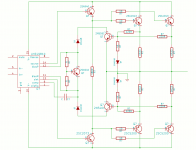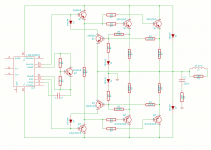Quasi Outputs/Lateral Mosfets
Thank's bobodioulasso for the info.
I'm a novice at this so could the BJT outputs be converted to Laterals such as the BUZ and Alfet types?
Sam
Thank's bobodioulasso for the info.
I'm a novice at this so could the BJT outputs be converted to Laterals such as the BUZ and Alfet types?
Sam
You asked for quasi complementary.
LME49810 and LME49830 can drive complementary mosfets directly.
http://www.national.com/profile/snip.cgi/openDS=LME49830
LME49810 and LME49830 can drive complementary mosfets directly.
http://www.national.com/profile/snip.cgi/openDS=LME49830
How do you guys using this driver chip do SOA protection? Can I just slap this off the bias pins assuming Q2/Q5 are on the drive pins?
An externally hosted image should be here but it was not working when we last tested it.
I shutdown the LME498xx driver chip when over current is detected by the output VI limiter. This removes the bias of output stage.
Or pull the source and sink pins down instead?
I prefer this arrangement. I use an opto-coupler to shutdown the chip as well.
Last edited:
How do you guys using this driver chip do SOA protection? Can I just slap this off the bias pins assuming Q2/Q5 are on the drive pins?
An externally hosted image should be here but it was not working when we last tested it.
What are the value of R2/R3 and R5/R6? B-E of Q1/Q4 can be reversed bias for high voltage leading to breakdown.
Can people who listened both famous LM3875 and this LME49810 compare sound quality if we take that LME would be used at power levels below 100W , for example +/-45V.
This thread is very long and there are many many schematics and variations.
Can you who follow this thread suggest(and link if possbile proven shematics) the best BJT implementation for one pair of BJT (maybe even darlingtons like datsheet of LME), or emmiter follower?
RARE NJL with thermal sensing diode come out of question because I cant get those easily. I would like to use 2SA1943(pnp) and its complement (npn). Any suggestons and comments about this specific BJT?
This thread is very long and there are many many schematics and variations.
Can you who follow this thread suggest(and link if possbile proven shematics) the best BJT implementation for one pair of BJT (maybe even darlingtons like datsheet of LME), or emmiter follower?
RARE NJL with thermal sensing diode come out of question because I cant get those easily. I would like to use 2SA1943(pnp) and its complement (npn). Any suggestons and comments about this specific BJT?
Here is a link for several output BJTs measurement http://www.diyaudio.com/forums/solid-state/170618-comparing-power-bjts-sanken-semi.html
I have a version for power about 60 W into 8 Ohms http://www.diyaudio.com/forums/chip-amps/153511-compact-sized-lme49810-11-thermaltrak-amp.html.
I have a version for power about 60 W into 8 Ohms http://www.diyaudio.com/forums/chip-amps/153511-compact-sized-lme49810-11-thermaltrak-amp.html.
Here is a link for several output BJTs measurement http://www.diyaudio.com/forums/solid-state/170618-comparing-power-bjts-sanken-semi.html
I have a version for power about 60 W into 8 Ohms http://www.diyaudio.com/forums/chip-amps/153511-compact-sized-lme49810-11-thermaltrak-amp.html.
do you have schematics if your 60W version and what is maximum power it can be used for (presume it have just one pair ) ?
But seems nobody used so far that BJT from Toshiba I mentioned before
1pair of 2sa1943/c5200 running from a 30+30Vac transformer should be good for 70W to 80W into 8r0.
They should be able to withstand the stress of driving a severe reactance 8ohm speaker.
You can get more power from 1pair but reliability at loud levels into real speakers will be compromised, eg 100W to 110W into 8r0 using a 35+35Vac transformer.
They should be able to withstand the stress of driving a severe reactance 8ohm speaker.
You can get more power from 1pair but reliability at loud levels into real speakers will be compromised, eg 100W to 110W into 8r0 using a 35+35Vac transformer.
1pair of 2sa1943/c5200 running from a 30+30Vac transformer should be good for 70W to 80W into 8r0.
They should be able to withstand the stress of driving a severe reactance 8ohm speaker.
You can get more power from 1pair but reliability at loud levels into real speakers will be compromised, eg 100W to 110W into 8r0 using a 35+35Vac transformer.
I can use than 2 pairs for up to 150W . I presume
what is best way of output configuration ? emmiter follower or darlongton , not single darlington of course, darlington with complementary pairs, more of them
It is usually known that emmiter follower has more distorsion than darlington.
I am looking for complete schematics, that is already tested, but all in all I will draw myself what I plan to make, than you can tell what you think...
Can anyone comment and compare LM3875 with LME. subjective sound quality comment
I am looking for complete schematics, that is already tested,
You can find the proven schematic in my web site and the latest one in this post http://www.diyaudio.com/forums/chip...e49810-11-thermaltrak-amp-23.html#post2305706
no, you need to change the voltage to get more power into the load.I can use than 2 pairs for up to 150W .
40+40Vac would get to your target of 150W, but I would not use 1943/5200 at this higher voltage, unless you are prepared to pay for the cooling of a 3pair output stage
I cannot confirm this.It is usually known that emitter follower has more distortion than Darlington.
I would expect a well proportioned double EF to perform better than any integrated Darlington.
If you want to use 2pairs in your output stages, then that allows you to send more current to the load. This might suit 6ohm or 4ohm speakers if you have any.
It is usually known that emmiter follower has more distorsion than darlington.
Most (probably 100 %) Darlingtons are emitter followers.
CFP has lower distortion than EF.
no, you need to change the voltage to get more power into the load.
40+40Vac would get to your target of 150W, but I would not use 1943/5200 at this higher voltage, unless you are prepared to pay for the cooling of a 3pair output stage I cannot confirm this.
I would expect a well proportioned double EF to perform better than any integrated Darlington.
If you want to use 2pairs in your output stages, then that allows you to send more current to the load. This might suit 6ohm or 4ohm speakers if you have any.
Of course, my question is just related to BJT dissipation .. not to voltage..
I do not mean integrated darlington... I mean discrete darlington with more pairs...
1943 is 225 V 15A bjt with 150W dissipation ....
why if we take that current performance is good, why for dissiaption 75W (150W amplifier) would require SO much paralell bjt, you say 4 pairs, is not that too much ?
- Home
- Amplifiers
- Chip Amps
- LME49810 - a new cousin for LM4702

